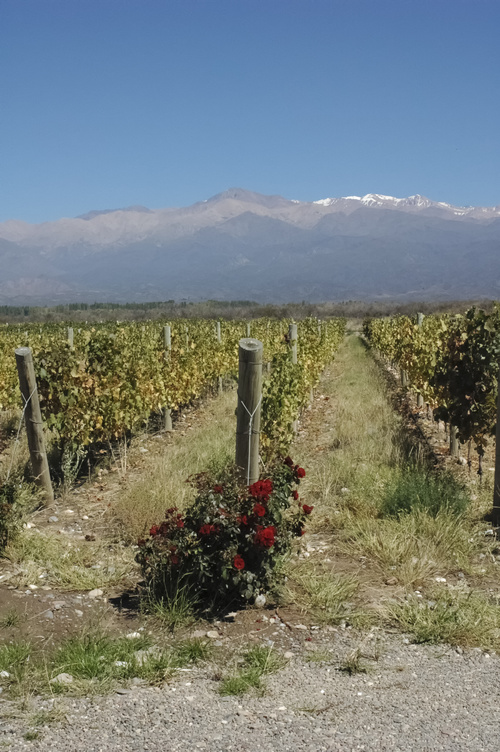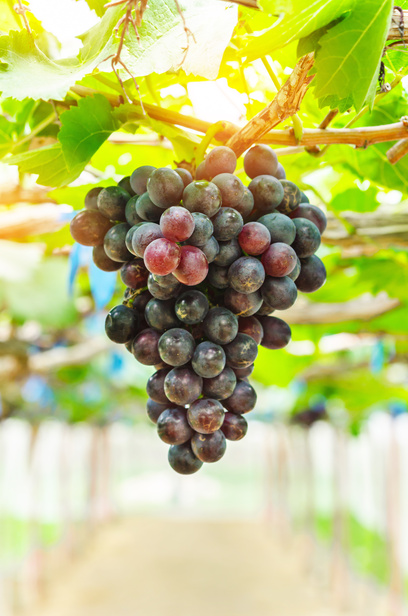Latin American Research Centre
we expand horizons

Malbec grapes and wine have been associated with Roman emperors, a crusading queen, medieval popes, renowned czars, and perhaps a treacherous court wizard. Its history “vibrates with romance, cosmic catastrophe, human contradiction…and finally happiness” (1) as the wine of choice for Roman legionnaires and poets, queens, kings, popes, czars, pilgrims, English and Irish drinkers, and as the rival of Bordeaux vintners. The varietal has been cultivated for centuries in France and the grape has made journeys around the world.
Today, tourists interested in fine Malbec wine can travel to various world locations. In the United States, they can go to California, of course, and also to the state of Washington, a region known for its white wines, which now also produces Malbec. Or they travel to Chile, where growers have shown a new interest in Malbec, especially done al estilo chileno in the Casablanca valley, near the Pacific Ocean. They can visit vineyards that grow it in Brazil and Mexico. Or they can travel to France to visit Cahors, the cradle (along with Tours) of this wine that they now call Malbec-Cahors. But in the mind of those around the world who enjoy this grape, Malbec remains the emblematic wine of Argentina.
Malbec has made Argentina a leading wine producing nation. It stands fifth in world production behind France, Italy, Spain and the United States. It holds sixth place in terms of consumption per capita, well ahead of South Africa and Australia. The most important region for the cultivation and production of Malbec is Mendoza and the surrounding areas on the slopes of the Andes of western Argentina.
Wine has had a place in Argentine history since its settlement by the Spanish, with the so-called criolla grape that arrived in the 1540s and established its importance as communion wine. Sometimes called the Barcelona of the Interior, Mendoza became the center of this wine production.

Improvement in the grape stock in the region did not come until mid-nineteenth century. On April 17, 1853, the Mendoza governor and his agricultural minister proposed to the legislature that the province establish a Quinta Normal and invite soil expert Michel Aimé Pouget to help develop the local wine industry. Legislators gave strong support to both provisions of the proposal. (Commemorating the decision in 2011, Wines of Argentina, the agency in charge of promoting the exportation of wines, recognized this date by choosing it as World Malbec Day.) Pouget arrived in the province later the same year and brought with him a large supply of seeds, plants, and grape shoots for Cabernet-Sauvignon, Pinot Noir and Malbec. (2)
These developments received a near fatal shock in 1861, when a tremendous earthquake almost completely destroyed the city of Mendoza. Recovery of the economy proved especially difficult, but finally with the leadership of Tiburcio Benegas (1844-1908) local agriculture, including the wine industry, began to revive. Other pioneers of viticulture in Mendoza were Honorio Barraquero, Juan Giol and Ramón Arias. These men along with Benegas laid the foundation for the wine industry in the region.
Their efforts succeeded because of major developments in the 1880s. Most dramatically, the railroad arrived, and with its steam locomotives came engineer Edmundo James Palmer Norton, who in 1895 founded the Norton winery. (3) A large number of European immigrants—especially from wine drinking cultures in Italy, Spain, and France—also arrived in Argentina, and created a critical market for the wines of the Cuyo region (especially the provinces of Mendoza and San Juan). (4) With the immigrants came a growing demand, especially in Buenos Aires, for Mendoza’s bulk, red wine. Growers produced the red table wine from a mixture of several varietals, including Malbec, for the growing market in Buenos Aires. This production continued for the next eight decades. (5)
Shipped in railroad cars, and distributed to customers in demijohns and barrels, the wine had to be served in pitchers. From the end of the 1940s to the 1980s, special carafes appeared in restaurants and homes. Popular bird-shaped jugs, called Penguins, became part of the national culture. Customers ordered wine, calling for a “penguin” or a “small penguin.” Sometimes the generally ceramic, amber or white penguins appeared to be dressed in tuxedos, and in some cases they were made of porcelain for wealthy families.
In 1910, a writer for the well-known national magazine, Caras y Caretas, wrote an article on the wines of Mendoza recognizing its high quality when produced with the Malbec grape. One vintner working with this grape was Nicolà Catena, an immigrant who arrived from Italy. He settled in Mendoza in the 1890s, and within three years he bought 10 hectares of land on which he began to cultivate the Malbec varietal. His son Domingo married Angélica Zapata, from one of the well-known families of the province, which allowed the family to extend its holdings and production. Around 1970, the family had become the largest producer of bulk wines in Argentina. But Domingo was confident that he could also produce fine wines, especially using the Malbec grape.(6)
The 1980s, known as the Lost Decade because of the economic catastrophe in much of Latin America, was a crisis period in the Argentina. The economy suffered classic stagflation with depressed prices, inflationary costs, and poor exchange rates that contributed to the collapse of exports. For the wine industry, the longstanding domestic market collapsed in part through over-production. Vintners destroyed two-thirds of their Malbec vines, reducing the plants from 40,000 hectares in 1980 to 15,000 hectares in 1990. (7)
Pressed by the economic crisis, some Argentine vintners recognized opportunity in the world market, if they could make essential changes. Argentines could seize their opportunity if, as Santiago Acheval, of Acheval-Ferrar Vineyeards, argued, they improved their grape stock and their vinification techniques. It was this opportunity and the Argentine response to it that resulted in the Malbec Boom.
One documentary film director followed the global market opportunity and Argentine efforts to claim it in the film Boom Varietal: The Rise of Argentine Malbec. He focused on the activities of families who had immigrated from Italy (although curiously completely ignoring the Catena family in the film). (8) Some Argentines developed a program they called reconversión. This developed a strategy to change the model away from internal consumption through three steps: improve the quality of the wine, modernize processes in both the vineyard and the winery, and seek foreign markets. Reconversión succeeded both because the Argentine growers had what one expert called an Agility Culture (“cultura de la agilidad”) and good luck. Certainly Argentina’s staggering economy allowed for large scale investments of foreign capital. In the decade between 1991 and 2001, the viticultural industry received investments valued at U.S. $1.5 billion, two thirds from foreign sources and one third from domestic investors. (9) Several producers used the investment to make changes in the fermentation process by replacing concrete vats that dated from the 1930s with modern stainless steel tanks.
These changes were achieved in part by local entrepreneurs, like the Catenas, who had begun in the Catena Zapata Vineyard in the 1970s. The son, Nicolás Catena, studied in Mendoza, earned a Master’s degree in economics at Columbia University, and later a doctorate in agricultural economics. After completing his studies, he returned and began to develop the vineyard and change the system of distribution, eliminating intermediaries to sell directly to wine dealers and shops. In the 1980s, the family vineyard sold a third of all the bulk wine consumed in the domestic market. Nicolás also began to turn his attention to the production of high quality wines. While a visiting professor in the economics faculty at the University of California-Berkeley in 1982, he used the opportunity to become familiar with California wines, which had just achieved success in a renowned tasting against French wines. Nicolás paid particular attention to the vineyard of Robert Mondavi, (10) and returned to Mendoza in 1983 determined to produce high quality wine for the world market.(11)
Catena said that initially in the 1980s he did not give much attention to Malbec because he did not consider it a high quality varietal, but rather it served to blend with grapes in the production of bulk wines for the domestic market. Initially, he planned to produce Cabernet-Sauvignon and Chardonnay for export, but he also recognized that his father Domingo had a dream of producing a Malbec varietal wine. With these plans in mind, Catena made significant changes in the vineyard. He replaced the huge, old kegs with small barrels of French oak. He also brought several viticultural experts to Mendoza, beginning with Pedro Marchevsky. Catena and Marachevsky identified 140 varieties or clones of Malbec. This resulted in experimentation to select a few for development in Catena vineyards, and led to the decision to move the plants higher up the slopes of the Andes for a different growing environment. (12) In 1988, Catena contracted Paul Hobbs, who had been working with Robert Mondavi, to help with the transformation of Catena Zapata wines. In addition to Catena, other Mendoza winemakers who made fundamental changes to take advantage of the opportunities in the 1980s were Ángel Mendoza and José Alberto Zuccardi.
 By 2003 the Catena Zapata Winery (previously known as the Esmeralda Vineyard) was producing 150,000 cases of wine from 5,400 acres that included 740 acres planted with Malbec. (13) In order to improve the quality, Catena hired various consultants, including the previously mentioned Paul Hobbs (California), Atiglio Pagli (Tuscany), and Jacques Lurton (Bordeaux). (14)
By 2003 the Catena Zapata Winery (previously known as the Esmeralda Vineyard) was producing 150,000 cases of wine from 5,400 acres that included 740 acres planted with Malbec. (13) In order to improve the quality, Catena hired various consultants, including the previously mentioned Paul Hobbs (California), Atiglio Pagli (Tuscany), and Jacques Lurton (Bordeaux). (14)
The Catena family has continued to develop Malbec and other wines of the region as the winery has maintained the largest volume of sales in the U.S. Nicolás’s older daughter, Laura, since 2001 has taken charge of the vineyard’s program of research and development. Her research skills have come from a medical education obtained at Harvard and Stanford Universities. She has experimented with varieties grown at different altitudes on the slopes of the Andes to learn about optimal microclimates. The research has become an essential aspect of production of the vineyard. Critical in these developments was adaptation to the subtleties of the terroir, defined as “climate, soil, superstition.” (15) Nicolás recognized all three, even the tradition of superstition, as he recalled that his father used a wizard who placed stakes with colored scarves among the vines. After his father’s death, Nicolás discontinued the practice, but he still respected his father’s approach. (16)
The success of Malbec has created an emblematic wine for Argentina. It received its first recognition in the global market during the 1990s. In June, 2001, the British magazine Wine for the first time published an extensive article on Argentine Malbec that included a tasting of 42 examples available in the United Kingdom. (17) Recognition of Argentine wines came in the United States in 1995, when Wine Spectator named the 1993 Catena Cabernet-Sauvignon as number 54 of the 100 best wines of the year. For the first time an Argentine wine made the list and it drew global attention that also attracted international investment in the vineyards. Two years later in 1997, the world’s most influential wine taster, Robert Parker Jr., gave 95 points to the 1997 Nicolás Catena Zapata Malbec. (18) Then in 2004, Wine Spectator for the first time awarded 94 out 100 points to an Argentine Wine, Achával-Ferrer‘s Malbec Mendoza Fina Altamira 2002. In another tasting of 150 red wines from Mendoza, 20 received 90 or more points.(19)
Malbec’s importance in the world of wines has also been registered in programs for television. For example, the PBS educational television program “In the Americas with David Yetmen,” in 2014 produced an episode, “Gift of the Andes: Mendoza, Argentina, and its Wines,” that included a segment on Malbec. The documentary “Malbec: Boom Varietal” is available for purchase on the internet. These programs have been shown in the United States and in Europe, contributing to the growing attention to Malbec. It deserves to be called a boom because the Malbec is now planted and the varietal wine produced in Chile, the United States (both in the Napa Valley region and Paso Robles in California, Washington state and Oregon), Australia, New Zealand, South Africa, Canada, Turkey, Moldova, Israel and Mexico.(20)
The success of Malbec wine demonstrates the importance of its energetic imaginative winemakers, its historical context, and its relationship to the environment. That is to say, the terroir, including the men and women and culture especially of the Mendoza region, have produced in all its variety the Malbec Boom.
(1) Michael Kenyon, A French Affair: A British Family at Home in Southwestern France (New York: St. Martin’s Press, 1992), pp. 146-7.
(2) Guyonne Blanchy, . La Viognoble Argentin de Mendoza et L’Influence Française: XIX-XXI slècle. (Paris: L’Harmattan, 2014) , p. 14
(3) “Pioneros, los visionarios de ayer,” Wine: Revista de Vinos y Comidas 3, 22 (2001). Pp. 10-17.
(4) Liliana Girini,. “Arquitectura Vitivinícola de Mendoza: Innovación y vanguardia en las bodegas de la Era Industrial,” Vinos & Viñas 991 (Agosto de 2004). Pp. 38-41.
(5) For the history of the criolla grape and its part in the development of the wine industry in New Spain, see Carona Páez, 2004.
(6) Vidal Buzzi, 2002, p.83; “Profile: Nicolás Catena.” EGOWINES 2003: Understanding the New World Wines of Argentina. Pp. 14 .
(7) Diego Bigongiari, editorial director, Austral Spectator, South America's premier winery directory.
(8) “Boom Varietal—The Rise of Argentine Malbec” (2011)
(9) Stein, 2008, pp. 7, 9, 12, 15
(10) The wine merchant Stephen Spurrier arranged a blind taste test by French experts of California and French wines in the Intercontinental Hotel , Paris, May 24, 1976. The results turned the wine world upside down because three of the highest rated white wines were from Napa and the number one red wine was the 1973 Stag’s Leap Cabernet Reserve, also from California. The taste test extended a significant reputation to California wines and created a new market paying high prices for them. Lawrence. Osborne,The Accidental Connoisseur: An Irreverent Journey Through the Wine World. (New York: North Point Press, 2004), pp. 32-33.
(11) Profile, 2003, p. 14; James Molesworth, “Argentina’s Dark Horse,” Wine Spectator (Dec. 15, 2003). p. 131; Anna Anna, Office of Public Relations,, Catena Zapata, Mendoza, Argentina, interview with the author, November 22, 2004.
(12) Laura Catena, Vino Argentino: An Insider’s Guide to the Wines and Wine Country of Argentina (San Francisco: Chronicle Books, 2010), p. 29.
(13) Molesworth, 2003, p. 131
(14) Molesworth, 2003, p. 132
(15) William Bostwick, The Brewer’s Tale: A History of the World according to Beer (New York: W.W. Norton, 2014), p. 96. For an enlightening discussion of the conception of terroir, see Amy Trubek, The Taste of Place: A Cultural Journey into Terroir (Berkeley: University of California Press, 2008). It was first used to link wines and place for the 1855 Bordeaux classifications. In 1905, French law tied food and drink to specific locations and Champagne producers were the first to use it. The process continued to the 1935 law of appellation d’origine. This has become the standard raised against homogenized global food and drink.
(16) Natalia Páez, “La curandera de tormentas,” Mitos y leyendas del vino argentio (Buenos Aires: Aguilar, Altea, Taurus, Alfaguara, 2011), 60.
(17) Choren, 2003, pp. 93-4.
(18) Molesworth, 2003, p. 131.
(19) James Molesworth, James. “Malbec’s Momentum; Argentina’s Premier Red Stars in the Outstanding 2002 and 2003 Vintages. “ Wine Spectator (Nov. 30, 2004), pp. 71-2.
(20) http://www.thewinecellarinsider.com/wine-topics/wine-educational-questio... ; Jancis Robinson, Julia Harding, José Vouillamoz, Wine Grapes: A Complete Guide to 1,368 vine varieties, including their origins and flavours (NewYork: HarperCollins, 2012), p. 274.
The views and opinions expressed in this
article are those of the author/s and do not
necessarily reflect those of the LARC.